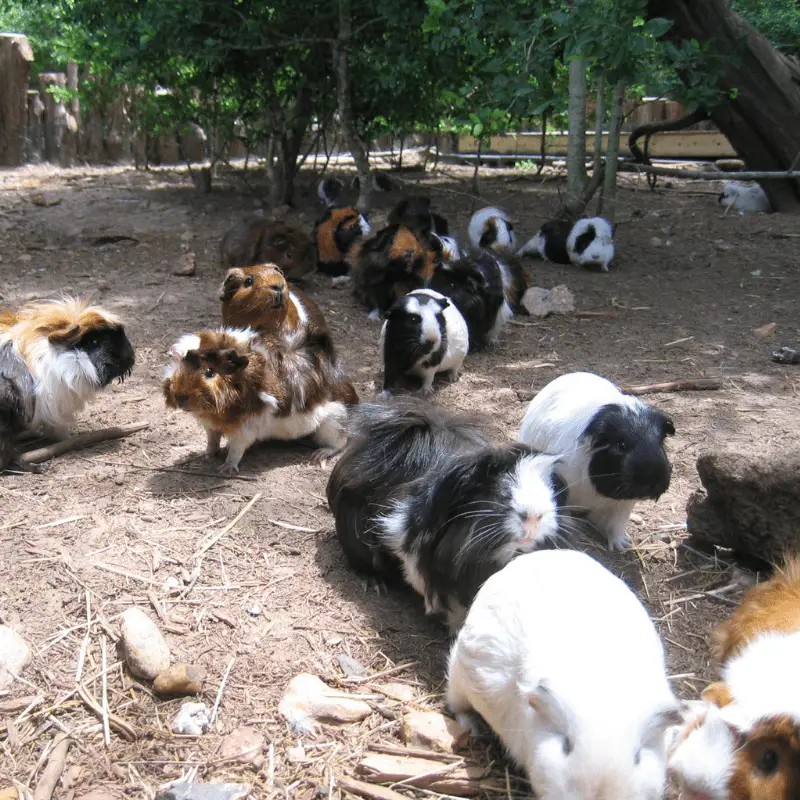Guinea Pigs are rodents from South America. They include the domestic guinea pig, wild cavies, and capybaras that live in various ecosystems across their continent, such as moist savanna or desert scrub.
A group of guinea pigs together is called a herd. A herd of guinea pigs can happen in the wild and captivity. Being in a herd for guinea pigs gives them companionship and protection from preditors.
What does herd mean?
A herd is a social group of animals that tend to stay together. They usually form from the need for protection or because they are members of an animal family. The herds can be very loud and frightening, but also beautiful as well!
Cavy
The Guinea pig, also known as Cavy (which is a term used by breeders); however, the scientific name is Guinea pigs, and this is most commonly used among Guinea pig owners.
Other names:
- Piggies
A wide variety of hair colours and patterns can be found on guinea pigs, and a breed that lacks fur is called a ‘skinny pig’. Male guinea pigs are often referred to by their title “boars”, whereas female ones go under the name “sows”.
Fact
Despite the common misconception, guinea pigs are not native to Guinea, and they have no relation biologically with a pig.
Origin
- Andes of South America.
What sexes can be found in the herd?
The majority of the time, there will be several females to only one or two male guinea pigs. However, in captivity, this can be slightly different. Having more males will result in more fights for dominance between them.
Are there baby guinea pigs in the herd?
Due to most of the guinea pigs making up each herd in the wild being female, there is a strong chance that there would be several baby guinea pigs in a herd at any one time.
How many guinea pigs are in a herd?
Guinea pigs live in herd groups of around ten adults in the wild, sometimes more if there are any baby Guinea pigs. In captivity, it depends on the owner and how many they have as pets. However, it would be best if you always had a pair at the very least.
Predator Behaviour (Herd)
Guinea pigs startle easily, especially when they sense danger, either freezing in place for long periods or running to cover with rapid, darting motions.
A startled herd of Guinea pigs is called a stampede, they move in random directions, and they do this on purpose to confuse the predator. The randomness of the herd’s movement makes the preditor either give up or only take the very few unfortunate ones.
Importance of the Herd
Not only being in the herd can protect themselves, but it also gives the Guinea pigs companionship. Guinea pigs love to be around each other and can get very lonely if they dont have a friend nearby. Unlike hamsters, these are solitary rodents and would rather be on their own. The Guinea pigs thrive on each other, and they often are a participant in social grooming.
Do they accept any guinea pig in the herd?
Guinea pigs are social creatures and will eventually bond with one another. It’s sporadic for two guinea pigs to not get along after a prolonged period, so generally, the issue is sorted through their dominance routine. Guinea pigs of the same sex will fight for dominance through biting at one another and simulated mounting. They may also start to shake their hair in an aggressive display and produce threatening noises and attacking head thrusts or leaping attacks. After this, the loser will back down within the herding group or join/make another herd.
What happens if a herd came face to face with another herd?
When two or more herds come together its referred to a colony of Guinea pigs
- Break out of dominance fights
- Bonding between Guinea pigs
- Mating between Guinea pigs
Recommended read:
Conclusion
Guinea pigs are called a herd, and these herds are critical to them for protection and companionship. Other animals also group and form herds and can be very noisy.

